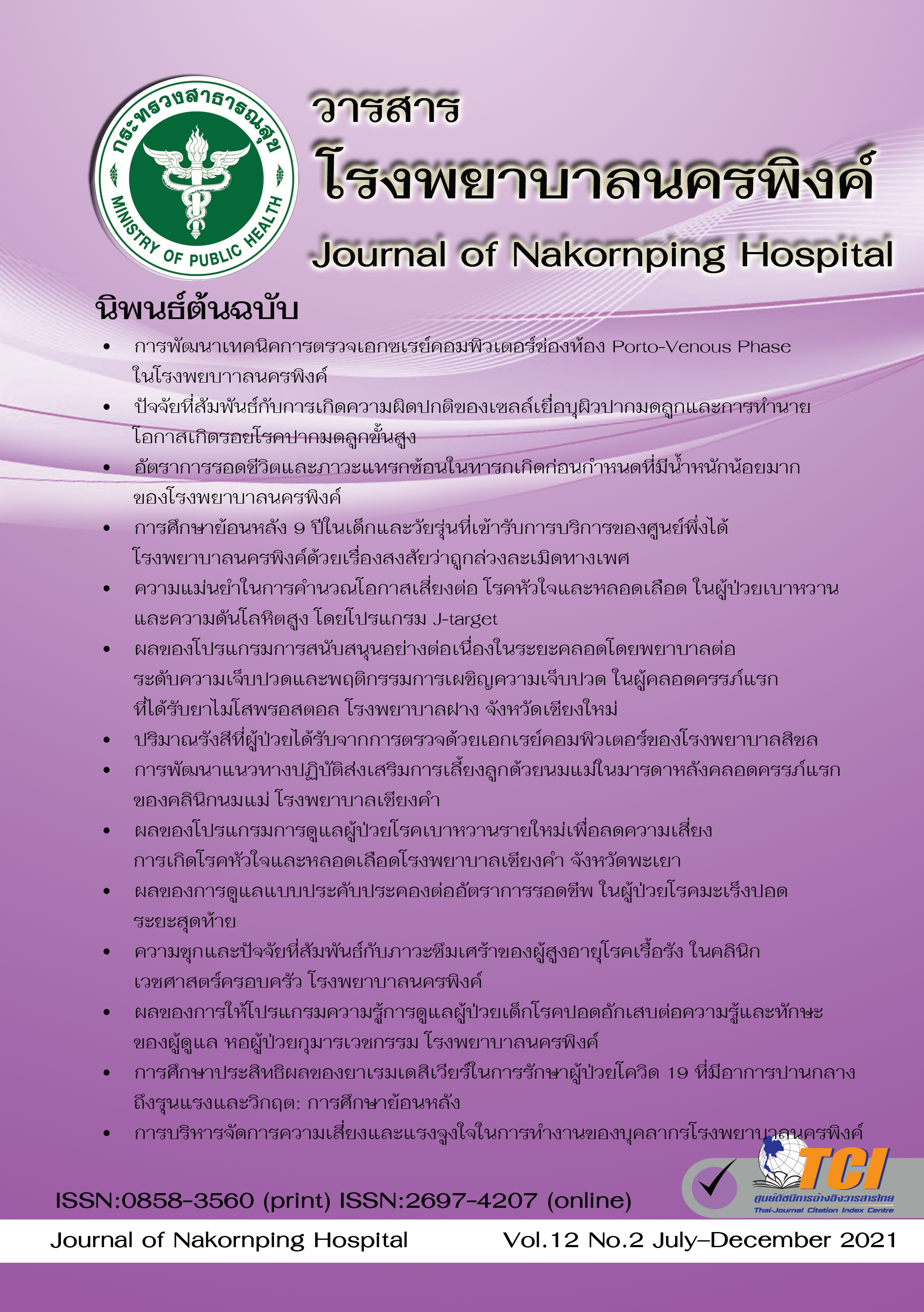Development of Abdominal Computed Tomography Techniques Porto-Venous Phase in Nakornping Hospital
Keywords:
Portal Venous Phase, Bolus Tracking, Fixed delay, LiverAbstract
Objective: To study image quality and contrast media dosage in patients undergoing portal venous phase computed tomography between bolus tracking method and fixed delay method
Method: A quasi-experiment 2 groups, comparing the use of two methods in patients undergoing portal venous phase computed tomography in the Nakornping Hospital Radiology Department, March 8, 2021-31 June 2021, first group using a fixed-delay method at 70 seconds after administration of contrast agents and the second group using a bolus tacking method in the aorta. The CT number use was 150 HU plus a 50 seconds delay time. The calculation of contrast media dosage was from the non-fat weight value calculation. The quality of the radiographs from the two methods was measured by CT number in the liver, aorta, portal vein and inferior vena cava. Radiographic assessment was assessed by radiologists. Data were also analyzed, Independent t-test and Wilcoxon's ranksum test when appropriate.
Results: Total 150 patients, mean (SD) age were 58.5 (13.8) years, male 83 (55.3%), female 67 (44.7%), body weight 54.9 (14.8) kg. Mean (SD) of CT number by bolus tracking method and fixed delay method in liver was 113.7 (10.9) HU. and 107.4 (15) HU. (p=0.004), in inferior vena cava was 116 (19.8) HU. and 109.8 (22.6) HU. respectively, p=0.62. Median (IQR) of CT number by bolus tracking method and fixed delay method in aorta was 154.5 (18.9) HU. and 143.7 (27.4) HU. (p=0.001), in portal vein was 153 (19.6) HU. and 140 (33.2) HU., p=0.002. The median (IQR) use of contrast agent in bolus tracking method 89 (23) ml while fixed delay method was 80 (20) ml, did not differ statistically (p=0.06), for quality assessment, median (IQR) mean scores evaluation image quality by radiologists of the bolus tracking method was 3.7(0.7), the fixed delay method was 3.3(1) statistically significantly different (p=0.03).
Conclusion: The development of abdominal computed tomography at Porto-Venous Phase in Nakornping Hospital using bolus tracking technique can significantly improve the radiographic quality.
References
โรงพยาบาลนครพิงค์. รายงานประจำปี พ.ศ 2563 [อินเทอร์เน็ต]. เชียงใหม่: โรงพยาบาลนครพิงค์; 2564 [เข้าถึงเมื่อ 15 กรกฎาคม 2564]. เข้าถึงได้จาก: http://www.nkp-hospital.go.th/th/dnFile/Report2563.pdf
โรงพยาบาลนครพิงค์, กลุ่มงานรังสีวิทยา. รายงานสถิติการให้บริการผู้ป่วยกลุ่มงานรังสีวิทยา โรงพยาบาลนครพิงค์ ปีพ.ศ. 2561. เชียงใหม่: โรงพยาบาลนครพิงค์; 2561
โรงพยาบาลนครพิงค์, กลุ่มงานรังสีวิทยา. รายงานสถิติการให้บริการผู้ป่วยกลุ่มงานรังสีวิทยา โรงพยาบาลนครพิงค์ ปีพ.ศ. 2562. เชียงใหม่: โรงพยาบาลนครพิงค์; 2562.
โรงพยาบาลนครพิงค์, กลุ่มงานรังสีวิทยา. รายงานสถิติการให้บริการผู้ป่วยกลุ่มงานรังสีวิทยา โรงพยาบาลนครพิงค์ ปีพ.ศ. 2563. เชียงใหม่: โรงพยาบาลนครพิงค์; 2563.
เมลิสสา พันธุ์เมธิศร์. แนวปฏิบัติการใช้สารทึบรังสีของกลุ่มงานรังสีวิทยา โรงพยาบาลนครพิงค์ 2563. เชียงใหม่: โรงพยาบาลนครพิงค์; 2563
Federle MP, Rosado-de-Christenson ML, Raman SP, Carter BW, Woodward PJ, Shaaban AM. Imaging Anatomy: Chest, Abdomen, Pelvis. 2nd ed. Salt Lake City, UT: Elsevier; 2016.
Burgener FA, Herzog C, Meyers SP, Zaunbauer W. Differential diagnosis in computed tomography. 2nd ed. Switzerland: Thieme; 2011.
Bae KT. Intravenous contrast medium administration and scan timing at CT: considerations and approaches. Radiology. 2010;256(1):32-61. doi: 10.1148/radiol.10090908
Kondo H, Kanematsu M, Goshima S, Tomita Y, Kim MJ, Moriyama N, et al. Body size indexes for optimizing iodine dose for aortic and hepatic enhancement at multi detector CT: comparison of total body weight, lean body weight, and blood volume. Radiology. 2010;254(1):163-9. doi: 10.1148/radiol.09090369
Krombach GA, Mahnken AH. Body Imaging: Thorax and Abdomen: Anatomical Landmarks, Image Findings, Diagnosis. Germany: Thieme; 2018.
Kanematsu M, Watanabe H, Kondo H, Goshima S, Kawada H, Noda Y. Portal venous-phase CT of the liver in patients without chronic liver damage: does portal-inflow tracking improve enhancement and image quality?. Open Journal of Radiology. 2013;3:112-6. Available from: https://www.researchgate.net/publication/275999676
Goshima S, Kanematsu M, Kondo H, Yokoyama R, Miyoshi T, Nishibori H, et al. MDCT of the liver and hypervascular hepatocellular carcinomas: optimizing scan delays for bolus-tracking techniques of hepatic arterial and portal venous phases. AJR Am J Roentgenol. 2006;187(1):W25-32. doi: 10.2214/AJR.04.1878.
Rosner B. Fundamentals of Biostatistics. 5th ed. England: Duxbury Press; 1999.
Boer P. Estimated lean body mass as an index for normalization of body fluid volumes in humans. Am J Physiol. 1984;247(4 Pt 2):F632-6. doi: 10.1152/ajprenal.1984.247.4.F632
Benbow M, Hennessy N, Vitale C. Timing of portovenous (hepatic) phase abdominal CT [Internet]. London: RAD Magazine [cited 2021 Feb 15]. Available from: https://www.radmagazine.co.uk/scientific-article/timing-of-portovenous-hepatic-phase-abdominal-ct/january-2019-timing-of-portovenous-hepatic-phase-abdominal-ct-matthew-benbow
Schweiger GD, Chang PJ, Brown BP. Optimizing contrast enhancement during helical CT of the liver: a comparison of two bolus tracking techniques. AJR Am J Roentgenol. 1998;171(6):1551-8. doi: 10.2214/ajr.171.6.9843287.
Downloads
Published
How to Cite
Issue
Section
License
The articles that had been published in the journal is copyright of Journal of Nakornping hospital, Chiang Mai.
Contents and comments in the articles in Journal of Nakornping hospital are at owner’s responsibilities that editor team may not totally agree with.



